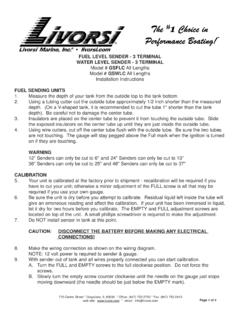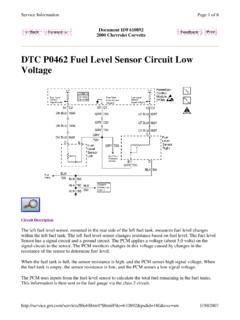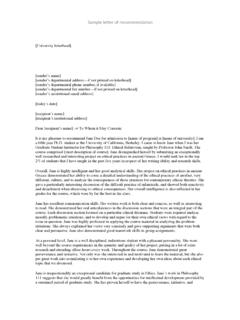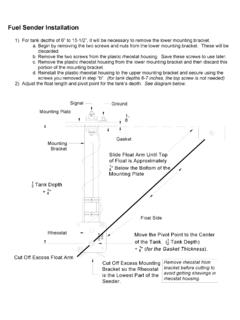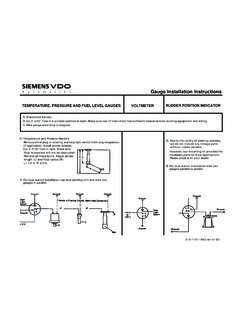Transcription of AUTOMATING THE MAIL FORARDING PROCESSW
1 Page 2 President:Nancy B. ClarkPO Box 427 Marstons Mills, MA President:Gerald (Jerry) NylanderPO Box 7123 Prospect Hgts., IL Secretary:Gerald (Jerry) Johnson6621 W. Victoria , WA G. Hendren12737 Glenage Hts., MO Wawrukiewicz3130 SW Wilbard , OR B. QuinePO Box 153 Bethel, CT NafzigerPO Box 1476 Albany, OR MerendaPO Box 20069 Ferndale, MI (Publicity):John HotchnerPO Box 1125 Falls Church, VA Markings - Issue 10 April 2006 AUTOMATING THE mail FORWARDING PROCESSby Michael M. LudemanIn the October 25, 2004, Notes column in Linn s StampNews, AMC member John Hotchner mentioned the U. S. PostalService s most recent effort to automate return-to-sender that column Bernie Moening of the Lima, Ohio post officeprovided a brief description of the new Postal Automated Redi-rection System, or PARS, focusing on its ability to automate themarkup of this return-to-sender mail endorsement.
2 As a resultof this column, I received an inquiry from another AMC memberwho wondered if PARS could be the source of the ink-jet spraymarking return-to-sender endorsements that Nancy, Tony and Iwrote about in the April 2005 issue of the Auxiliary was a good question and one which I had consideredwhen I first read about PARS in the 2004 edition of the Compre-hensive Statement on Postal Operations. I made some inquiriesat that time and obtained some detailed information on PARS anddetermined that PARS and the First Class Letter mail AutomatedEndorsement Return-to-Sender Program were distinctly differ-ent programs. However, since this question had been raised againby a second individual, it appeared that this might be a good op-portunity to provide some additional descriptions of PARS andits preceding program, the Computerized Forwarding System(CFS), so that our readers would have a better understanding ofhow these two programs functioned and why they were differentfrom the RTS the first 200 years of Postal Service operations, the act offorwarding the mails was both a destination-oriented activity anda labor-intensive manual one.
3 By destination-oriented, I am re-ferring to the fact that the letter traveled to its destination beforeany forwarding actions could be its arrival at the origi-nal destination address, the postmaster or mail carrier would ex-amine the letter. If it was on his list of addressees who had movedand left forwarding instructions, then he would make a notationof the new address and return the letter to the mailstream for de-livery. The first effort by the USPS to automate part of this pro-cess occurred in 1987 with the introduction of the CFS. For ourpresent interest CFS can be described in terms of three primaryfunctions: (a) data entry of change-of-address (COA) data into acomputerized database, (b) matching forwardable letter mail withthe appropriate entry in the COA database and automatically cor-recting the destination address and (c) notification of COA s tomass mailers who desired to keep their mailing lists accomplished these functions in the following customers continued to fill out a Change-of-Address formthat identified the name and old and new address of the is PS FORM 3575, June 1991, for CFS, shown in form is on green card stock and printed in black ink.
4 Othervariants were probably used. These cards were sent to one of about240 centralized locations where this information was keyed byoperators and placed into a local COA database on a daily local COA databases essentially reflected all of the COAdata for a designated Processing & Distribution Center (P&DC).In addition, on a weekly basis, these changes were merged into aNational Change-of-Address (NCOA) database. This NCOA da-tabase was not used directly in the forwarding of mail but to pro-vide address correction and update services to mass mailers. TheCFS consisted of a stand-alone system installed at each of the280 or so P&DCs across the United States and is occasionallydescribed as the Redirection System. Each CFS consisted of amail transport, a video lift station and display, an Optical Charac-ter Recognition (OCR) module, a computer, a label applicationSummary: Prior to 1987, for the first 200 years of Post Of-fice Department/Postal Service operations, the act of forwardingthe mails was both a destination-oriented activity and a labor-intensive manual one.
5 (1) The First-Class Letter mail Automated Endorsement Re-turn-to-Sender (RTS) Program (circa 1989), described in the April2005 newsletter, is simply an automated capability for markingthe Return-to-Sender endorsement on such mail identified byother sources. In this case the responsibility for forwarding themail lay with the destination post the introduction of the Computerized Forwarding Sys-tem (CFS, 1987) and the Postal Automated Redirection System(PARS, 2003),the responsibility for forwarding the mail shiftedfrom the destination post office to intermediate facilities such asthe Processing & Distribution Centers (P&DCs) and Destina-tion Delivery Units (DDCs).(2) The Computerized Forwarding System (CFS) shifts partof the forwarding responsibility from the destination post officeto local (near the destination city) P&DCs and DDCs.
6 The desti-nation post office still bears the responsibility for identifying suchmail, but the P&DCs and DDCs handle the addition of the newforwarding address.(3) Postal Automated Redirection System (PARS) shifts theresponsibility for identification of mail that is to be forwardedback to the P&DC at the point of entry of the 3 Auxiliary Markings - Issue 10 April 2006module with an ink-jet printer and a small number of outputsortation the post office level, the letter carriers and clerks continuedto identify mail that was to be forwarded. It is my assumption atthis point that each post office received summaries of the COAforms filed by their local customers from the process that inte-grated this COA data into the local database.
7 When a letter to beforwarded was identified, the carrier deposited it into a CFS con-tainer which was transported to the P&DC on a daily basis, eitherafter all of the incoming mail had been worked at the post office,or perhaps when all of the outgoing mail was transported to theP&DC for processing at the end of the work day. All of this CFSmail was consolidated and processed by the CFS. This processingconsisted of the following steps. The address side of the letterwas scanned and presented to the redirection clerk who extracteda code from the address which was the index key to the lookup inthe local COA database. This key consisted of the first four lettersof the addressee s last name and the last three numbers of thestreet address.
8 This key was then used to search the local COAdatabase, and if a match was found, a redirection label (on yellowpaper) was printed with the new address, including the POSTNET barcode. The label was then attached to the envelope, and theenvelope directed to the appropriate sortation bin. Figure 2 showssuch a CFS label with the index key CARL077. For reasons ofprivacy, part of the addressee s name is erased in Fig. 2, 3, & 2 (CFS)Figure 3 below, showing a PARS label, is out of order so thatthe reader can compare the CFS and PARS label formats here. Figure 3 (PARS)The PARS label in Figure 3 can be compared with the CFSlabel in Figure 2. The best way to distinguish the two is that mostPARS labels have both the 7 character COA database key ( ,CARL574) and the BC (barcode) line while the CFS label hasonly the 7 character COA database key ( , CARL077).
9 Excep-tions do exist, usually where there is too little room on the labelFigure 1 - PS FORM 3575 (CFS)Page 4 Auxiliary Markings - Issue 10 April 2006for the BC the CFS system, there were several other events which couldhappen. The USPS forwards mail for 12 months, then for the next6 months the mail is returned to the sender with the new addressprinted on the yellow label. The COA data is maintained for alonger period of time. When a match is made after this 18 monthperiod has been exceeded, a different message is printed on thelabel advising the sender that the forwarding order has , in this instance, the words RETURN TO SENDER areusually placed on the yellow label. An example of this type oflabel from CFS is provided in Figure 4.
10 Incidentally, note the RETURN TO SENDER FOR REASON SHOWN ink-jet mark-ing of the RTS process on the envelope. Figure 4 (CFS)Theoretically, a key derived from the address could fail tomatch an entry in the local COA database. What happens in thissituation is unclear and not covered in my information. My specu-lation is that the CFS prints a label to the effect: UNABLE TOFORWARD/NO FORWARDING ORDER ON FILE/RETURN TOSENDER. The letter would then be returned to a clerk for processing by the CFS, these letters are placed back inthe outgoing mailstream where they are sorted along with regularmail and sent onward to their new the CFS processing, the redirection operator also wasrequired to watch for and flag those forwarded letters which hadancillary service endorsements such as Address Correction Re-quested, Do Not Forward or Do Not Return.

